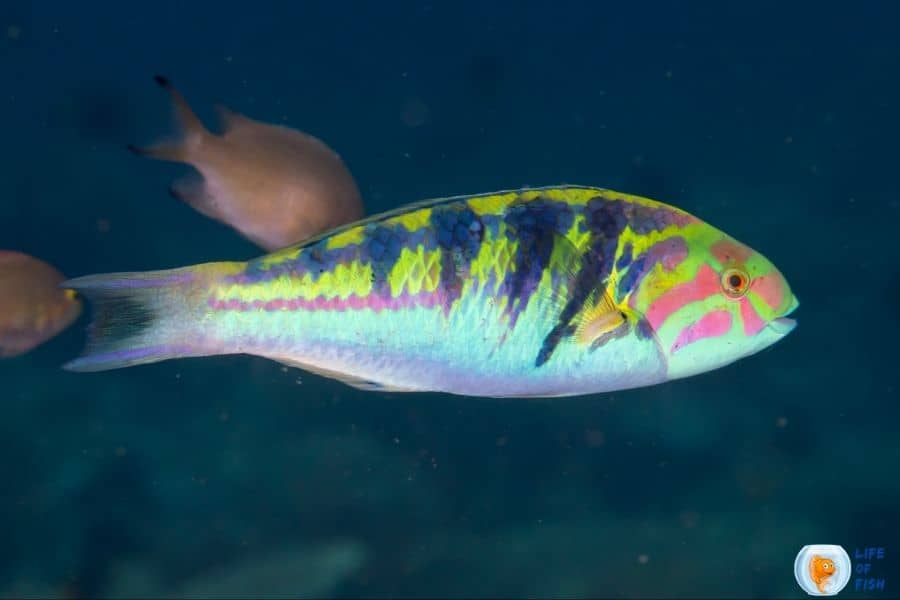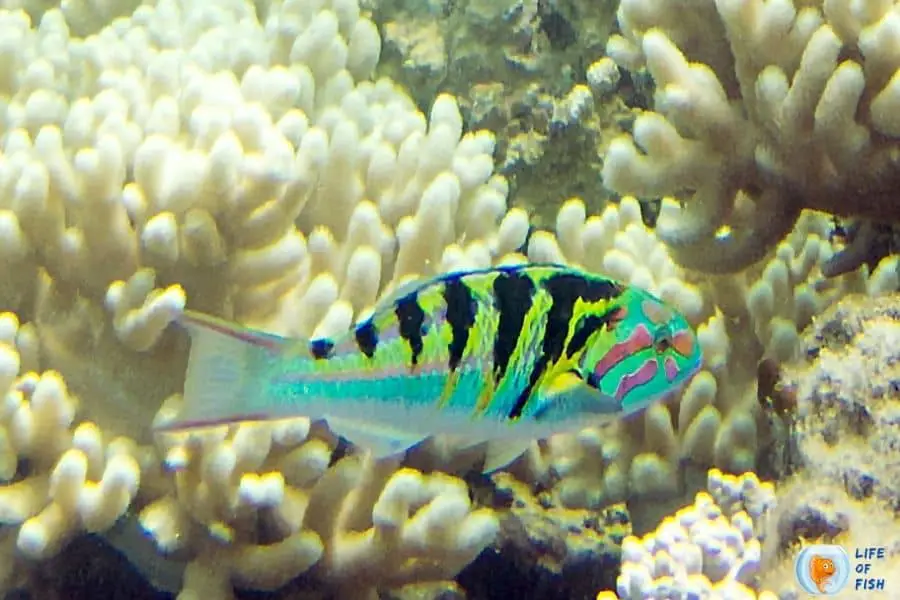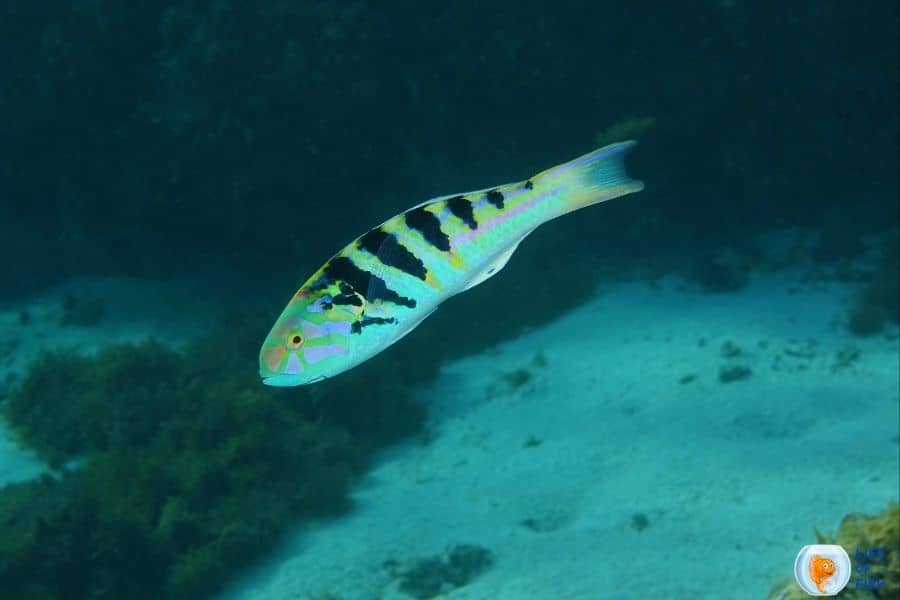Sixbar wrasse, as the name suggests, has six vertical bars in its body, which gives it a unique and attractive look. Also known as the Hardwicke Wrasse and Hardwick’s Wrasse, Sixbar wrasse is a wonderful addition to a marine aquarium.
Although this is a hardy and long-lived wrasse species, they possess the aggressive behavior of many wrasse species. Therefore, you must have some knowledge about keeping aggressive fish in your aquarium. This makes them not beginner-friendly, but if you happen to have a sixbar wrasse in your aquarium, this guide will certainly help you.
Before buying a this fish, keep in mind that it is very difficult to breed them in captivity.

One Look Care guide
Jump To
| Scientific name | Thalassoma Hardwicke |
| Common name | Sixbar wrasse Hardwicke Wrasse Hardwick’s Wrasse |
| Care level | Moderate |
| Native to | Southeast Asia (including Indian Ocean, China Sea, and the Philippines) and also in parts of Australia |
| Type | Saltwater fish |
| Color | Greenish body with six dark bars |
| Tank size | 75 gallons |
| Preferred temperature | 72 to 78 degrees Fahrenheit |
| Other water parameters (ammonia, etc.) | pH level: 8.1 to 8.4 Salinity level: 1.020 to 1.025 Hardness: 8 to 12 dKH |
| Preferred salinity | 1.020 to 1.025 |
| Size | 20 cm (8 inches) in the wild 4 to 8 inches in captivity |
| Life Span | Up to 10 years |
| Temperament | Aggressive |
| Recommended tank mates | Large, aggressive fish |
| Preferred food | Carnivore, pellets, flakes, crustaceans, live and frozen food such as brine shrimp, bloodworms and mysis |
| Feeding frequency | Several times per day |
| breeding | Not done in captivity, egg layers |
What is Sixbar wrasse?
They are a member of the wrasse family, and it belongs to the genus Thalassoma. They are widely found in South East Asia (including the Indian Ocean, China Sea, and the Philippines) and also in parts of Australia. They are one of the most attractive wrasse species in the wild. Six horizontal bars on its body give them a unique and attractive look.
This fish is a large, active fish with a typical wrasse body structure. It has an elongated body covered with scales.
Their head is large, and the mouth is small, placed on the underside of the head. This means that they are primarily bottom feeders, which primarily feed on shrimps, crabs, and mollusks. Sixbar is relatively hardy and lives long without much difficulty. They are very expensive fish and can cost more than $50.
Ready to take your knowledge of wrasse fish to the next level? Our hub article is a must-read for any fish enthusiast! – wrasse fish
- How big do Sixbar wrasse get?
They are relatively large fish and can grow up to 20 cm (8 inches) in length. However, they usually grow up to 6 to 7 inches (15-18 cm) in captivity.
Are they aggressive?
Their aggressive behavior is because these fish is a hunters, and they can easily prey on smaller and more peaceful fishes in your aquarium. However, if you keep larger and more aggressive fish in your aquarium, they will not attack them.
Their behavior
As adults, these fish prefer to live alone or with small groups of their species. However, juveniles tend to live with groups. They are aggressive and often harass and eat smaller fish species. These fish become aggressive when introduced to new tank mates (With careful steps taken, you can prevent this behavior.) They will also fight with peaceful fish, even if they are larger than them.
Interestingly, these fish do not sleep like Halichoeres wrasses and Leopard Wrasses, which sleep during the night under the sand in your aquarium. They prefer to sleep wherever they like, and therefore you often find them sleeping under rocks, plants, caves, and other hiding places. However, this wrasse will rest on sandy ground and may burrow into it when startled.
How long do they live?
Sixbar wrasse is a long-lived fish and can live up to 10 years with proper care. However, most of these fish do not live longer than 8 years because of their fast growth rate.

Sixbar wrasse care
They are easy fish to care for if you keep it in a large aquarium with suitable tankmates. They do not eat corals but are not considered reef-safe as they tend to eat small crustaceans, and invertebrates live among corals. Sixbar wrasses are best kept in a fish-only aquarium with larger, aggressive tankmates.
- Size
They can grow up to 8 inches in the wild, though they grow only about 4 to 8 inches in captivity.
- Tank size
Due to their somewhat large size and active behavior, these fish require a large aquarium. A minimum of the 75-gallon tank is recommended for one fish.
If you intend to keep any tank mates, a minimum of a 125-gallon aquarium is recommended.
How many fish should be kept together?
You can keep up to one fish in a minimum of a 75-gallon aquarium. If you want to keep more than one Sixbar, the minimum tank size should be a 125-gallon aquarium. However, you should house no more than two sixbar in one tank as they are extremely aggressive toward each other. Further, the pair should be a male and a female specimen.
Tank setup
They are not demanding when it comes to setting up the tank. Sixbar can live in just about any environment, including reef aquariums. However, these fish may ruin the corals by eating off small crustaceans and invertebrates that live there. Therefore, it is best to keep them in a fish-only aquarium with bigger, aggressive tankmates.
- Substrate
The substrate should consist of sand as they often burrow in it and sleep under rocks and plants. However, you might not need a deep sand bed as they can rest on it without burrowing into the sand.
- Lighting
Since they are not partial to light, you can keep them in any kind of lighting setup.
- Water movement and filtration
They can live in waters with low turbidity, and therefore moderate to high water movement is recommended. Provide good filtration as these fish are messy eaters.
- Decorations
Provide a wide variety of rocks, plants, and caves for these fish to hide in. Sometimes, these fish can be shy and like to sleep under rocks and plants.
Thus, the more you provide, the better it is for them. You can also keep a sand bed to make your fish feel comfortable.
- Tank lid
As they are jumpers, keeping your tank lid closed all the time is important.
Water quality condition
They have no special requirements when it comes to water parameters. However, keeping them in warmer water is suggested as they grow at a faster rate and are less shy in warmer waters. Keep the temperature between 72 and 78 degrees Fahrenheit. Make sure that the water temperature is not below 72 degrees Fahrenheit, as this can cause shock to your fish.
- pH level
The pH level of the water should be between 8.1 and 8.4.
- Salinity level
Keeping salinity at the level of 1.020 to 1.025 is suggested unless you keep them in reef aquariums where higher salinity is recommended.
- Water hardness
The water hardness for the fish should be between 8 and 12 dKH. Additionally, the tank requires 10% water changes biweekly or 20% water changes monthly to maintain water quality.

Sixbar wrasse breeding
Like any other wrasse species, they have not been bred in captivity. According to records, these fish are oviparous, which means they form pairs during the breeding season. They are egg-laying fish that fertilize the eggs via external fertilization. Males acquire a flamboyant hue and a black dot in the middle of their caudal fin during mating season.
male or female identification
The male is brighter than the female specimens. However, the terminal males (females that change into males) tend to become gaudier than the primary males (born males). The color pattern remains the same until the fish change into a male. There’s no difference in terms of body shape or size between males and female.
How to feed Sixbar wrasse ?
They are carnivore fish that eat benthic and planktonic crustaceans, worms, shrimps, octopus, and small fishes. These fish are not picky eaters so you can put any nutritious food into the tank. They are easy fish to feed as they have a hearty appetite. They will eat almost anything you give them, including pellets and flaked food.
In the aquarium, you can feed these wrasses with pellets, flakes, crustaceans, and live and frozen food such as brine shrimp, bloodworms, and mysis. They are constantly hungry because they constantly work as cleaner fish and pick parasites off other fishes. Six bar wrasse is a very hardy fish that can eat a wide variety of meaty food.
What fish can live with Sixbar wrasse?
Due to the aggressive nature of the sixbar, it is not easy to keep these fish in a community tank. They are not friendly with their own kind or other species; therefore, they should be kept in a species-only tank. Some fish are more tolerant of their presence, while others are more prone to prey. If you want to keep your sixbar with other fish, provide them with plenty of hiding spaces and avoid keeping slow-moving fish in the same tank with these fish.
Fishes that can live with Sixbar include groupers, angelfish, triggerfish, and hawkfish. Do not house small fish and crustaceans with sixbar wrasse as they will eat them. Tankmates should be of the same size as the sixbar wrasses or larger, as these fish will not bother larger fish.

Related questions
Are Sixbar wrasses rare?
They are not rare and widely distributed in the tropical waters of the Indian Ocean and the Pacific Ocean. There are no major threats to these species, such as commercial fishing and habitat destruction. Sixbar wrasse is not rare and is categorized as Least Concern by the IUCN red list of threatened species. However, they are not common in the aquarium trade and are sold for about $40 – $50 per fish.
How long does a Sixbar wrasse live?
They are believed to live for 7 to 10 years in the wild, but there are no apparent records of its lifespan in captivity.
Are sixbar wrasse reef safe?
They will eat small crustaceans and worms that live on rocks and coral, but they will not bother your corals. However, they are considered not reef-safe because of their hearty appetite and aggressive nature. They will consume any fish that is small enough for them to swallow.
Conclusion
Sixbar wrasse is a beautiful addition to your aquarium if you have a large tank with large, aggressive fish. They are very hardy, easy to feed, and have a good appetite for meaty food. However, they need a large tank when kept with other fish. If you have some experience keeping a saltwater aquarium, you’ll find Sixbar wrasse is not difficult to keep.
Read Next : Humphead Wrasse | The Amazing Gender-Shifting Fish | Ballan Wrasse | More About Beautiful And Unpopular Fish |
